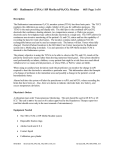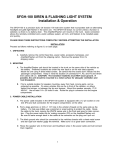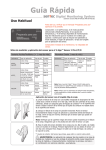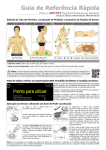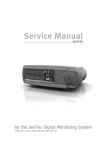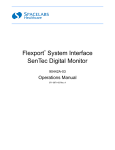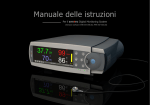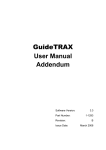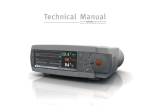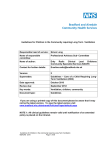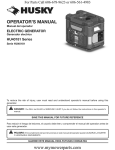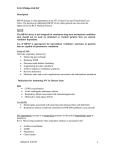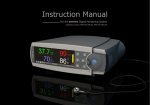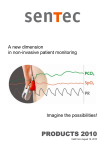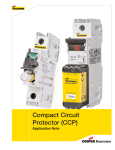Download 603.1 Sentec Transcutaneous Monitor 603.1/ Page 1
Transcript
603.1 Sentec Transcutaneous Monitor 603.1/ Page 1 of 8 Description The Sentec Digital Monitoring System (SDMS) is for the continuous and non-invasive monitoring of carbon dioxide tension (PCO2). Carbon dioxide (CO2) can readily diffuse through the tissue and skin. With an adequate sensor it is possible to measure CO2 at the skin surface. The primary objective in using the TCM is to be able to observe the CO2 trends of the patient by noninvasive means rather than drawing numerous blood gases. This system should be used preferentially on infants or children or any patient that might be at risk from too much blood withdrawal or too many arterial punctures, or labile PaCO2 values. PcCO2 measured at a specific site and at a given temperature reflect equilibrium depending on several parameters: • Arterial carbon • Local skin blood flow • Metabolism (producing CO2) • Skin structure • Diffusion properties of the skin For assessing PaCO2, the dependence of TcCO2 from the other parameters is minimized by two measures: 1. Warming up of the measurement site: increase capillary blood flow in the skin under the sensor (local arterialization) and diminish the arterio-venous PCO2 difference, stabilizes metabolism and increases gas diffusion 2. By selecting an appropriate measurement site the influence of the skin structure on PcCO2 is reduced. Appropriate sites are skin areas with: high density of capillaries, ample capillary blood flow, then epidermis and little or no deposition of fat. Limitations of TCM measurements Clinical situations or factors limiting the correlation between cutaneous and arterial PCO2 values: • Arterio-venous shunts • Hypoperfused measurement site due to low cardiac index, shock, hypothermia or vasoactive drugs • Condition of patient’s skin and subcutaneous tissue • Interference with anesthetic gases A built in alarm system will alert the practitioner to tcPCO2 values exceeding the limits that have been set. RCS SFGH Adopted 12/2013 revised 2/2014 603.1 Sentec Transcutaneous Monitor 603.1/ Page 2 of 8 The battery will last 6 hours when fully charged. The unit should be plugged in at all times, however the power should remain off to reduce the continuous use of calibration gas that occurs when the unit is in standby mode. Keep the sensor positioned in the docking station door to prevent damage to the sensor when not in use or while in calibration mode. Physician’s Order A physician must order “Transcutaneous Monitoring”. The monitor should only be used in 6H NICU, 4E, 5E or 5R. The unit is not to be used on 6A unless approved by the Respiratory Care Supervisor. Equipment Needed Sentec Transcutaneous Monitor consists of the following parts: • V-Sign Sensor/cable (extremely fragile, the cables cost $3000.00 please handle with the utmost care) • Disposable fixation rings • Earclip for adult or pediatric application • Alcohol swab or hospital grade cleaning wipes • Contact gel • Calibration gas cylinder placed securely in the back of the analyzer. • • Membrane kit o Membrane changer (RCS will change the membrane when required. Membranes are very expensive and require some degree of skill and training). The life of the membrane is 42 days, at that time a reminder will display on the face of the Sentec indicating it is time to change the membrane. After the membrane is changed, Confirm membrane change (the membrane timer only resets if you confirm the membrane change on the monitor. The menu “Membrane Change” is only accessible if the Docking Station door is open. User’s Manual Calibration • The Sentec Digital Monitoring System is equipped with a self-contained calibration system. The Docking Station (DS) will allow a fully automatic PCO2 sensor calibration. The calibration tank contains 8% CO2 serves as a CO2 reference. Keep in mind when the tank remains in the SDM while powered on and “Ready for Use” the sensor is RCS SFGH Adopted 12/2013 revised 2/2014 603.1 Sentec Transcutaneous Monitor 603.1/ Page 3 of 8 • Periodically recalibrated. This frequent calibration will empty a tank rapidly. When the SDM is not in use, keep unit plugged into electrical outlet and powered off. • Power on. Calibrate the monitor. A calibration is necessary when the monitor is first powered on, when the sensor is re-membraned, between site changes and when the SDM display says, “hey, calibrate me now” Calibration of the sensor occurs automatically when the sensor is positioned in the docking station and the SDM is powered on. Once the sensor has been calibrated, the screen will display “Ready for Use”. The sensor must be placed on the patient’s skin with the fixation ring within 2 minutes or the monitor will require recalibration. The SDM will display a message on the screen indicating when a calibration of the sensor is required. • • Changing of the Sensor Membrane If the “Membrane Change Interval” has elapsed, the SDM displays the message “Change sensor membrane”, triggers a low priority alarm, activates the menu “Membrane Change” The sensor membrane of the V-Sign™ Sensor must be changed using the V-Sign™ Membrane Changer. Open membrane changer and insert new membrane disposable setup into chamber, close changer, lining up the opening, The membrane change procedure consists of the following four steps: 1. remove old sensor membrane 2. clean sensor surface, 3. apply new electrolyte on sensor surface. 4. Keep the Membrane Changer horizontal while repeating the following procedure 4 times: 1. Place the Membrane Changer on a solid flat surface such as a table top. RCS SFGH Adopted 12/2013 revised 2/2014 603.1 Sentec Transcutaneous Monitor 603.1/ Page 4 of 8 2. Hold the sensor head horizontally (membrane up) and insert it into the Membrane Changer. Press down slowly but firmly with palm of hand and hold for 3 seconds. 3. Press down firmly with the palm of your hand until the top portion of the changer “CLICKS” into place. Note: Do not touch or hold the sensor cable while the sensor is inside in the membrane changer, as this may dislodge the sensor from the membrane changer. 3. Hold the base of the membrane changer with one hand and turn top clockwise with the other hand to the next stop. Repeat this process 3 additional times. Important: Be sure to perform the Press, Click and Turn procedure 4 times. Lift the sensor and remove it from the tool. Inspecting correct placement of sensor membrane 1. Verify that the membrane ring is securely seated on the sensor RCS SFGH Adopted 12/2013 revised 2/2014 603.1 Sentec Transcutaneous Monitor 603.1/ Page 5 of 8 2. Verify that there are no air bubbles between the membrane and the sensor 3. Verify that there are no wrinkles or tears of the membrane. 4. Confirm the membrane change on the Sentec monitor in order to reset the membrane timer – the docking station door must be open to activate the membrane reset menu option. Procedure Before Applying to Patient 1. Inform the nurse assigned to the patient that: a. The electrode and the cable combine to form a sensitive and fragile piece of equipment. b. The pCO2 portion of the electrode should not be left dangling or allowed to drop on the floor. c. Stress or tension should not be applied to the cable. d. Replacement cost of electrode is $3000.00. Application to Patient/Site Change 1. The electrode temperature defaults 41 degrees for neonates and 43 degrees for adults. 2. Choose an appropriate measuring site on the patient; for neonates - the chest or abdomen or inner thigh if size permits. 3. Remove the protective lining from the fixation ring and place the ring on the measuring site. 4. Place 1 drop of the contact gel on the skin through the hole of the fixation ring. 5. Place the nose of the sensor at an angle pressing against the edge of the ring. Gently lower the sensor into the fixation ring until it clicks into place. Rotate the sensor back and forth a few times to evenly distribute the gel for optimal contact with the skin. The tcPCO2 values should stabilize in approximately 5 minutes. 6. If you find that too much pressure is applied when placing sensor in ring, connect fixation ring to sensor, squeeze one drop of gel in the middle of sensor, remove O-ring lining and secure sticky ring to skin site. Holding the neck of the sensor, rotate sensor back and forth to evenly distribute the gel. 7. After stabilization of values, set the high and low alarm limits. RCS SFGH Adopted 12/2013 revised 2/2014 603.1 Sentec Transcutaneous Monitor 603.1/ Page 6 of 8 8. Calibration of sensor. Patient’s <1000grams, change site every 6 – 8 hours, increasing to every 8 hours if skin integrity tolerates. If a red mark still remains after 6 hours, either decrease the temperature or change the site more frequently. NOTE: Clean Sensor head and black rubber gasket inside docking station between calibrations to prevent a buildup of sticky gel. If not kept gel free, the gasket may dislodge and create a calibration gas leak. Sensor Application using an Ear Clip (Adult or pediatric patients) 1. 2. 3. 4. Verify that the message “Ready for Use” is displayed on the monitor. Check the current patient profile, select the patient mode (Adult) Select Temperature settings and monitoring time Clean the earlobe with an alcohol swab and let air dry, insert the sensor into the Ear Clip, remove both covers of adhesive tapes and place one drop of contact gel on center surface of sensor. Hold sensor such that the contact gel does not roll off the sensor face 5. Pull earlobe in horizontal position. Move the sensor horizontally into place and attached to the back of the earlobe. Close clip from above, then guide earlobe back in vertical position. NOTE: Verify that the whole dark surface of the sensor is covered by the earlobe. Ensure that air gaps are eliminated between the skin and the sensor. 6. Wrap cable around the ear once and tape the cable to the cheek. Provide a small squeeze with your fingers to the sensor and earclip as a final securing action. Secure sensor cable with clothing clip on patient gown or linen NOTE: Applying pressure to the measurement site with a pressure bandage/tape may cause pressure ischemia at the site and consequently, inaccurate measurements, necrosis or in combination with heated sensor – burns. Patient Assessment/Reassessment The patient’s response to procedures should be assessed and reassessed. Patient assessment and reassessment should be performed according to the general RCS policy (see Section IV – Patient Assessment/Reassessment in the RCS Policy Manual). Complications • Skin burns: The TCM causes arterialization of an area by means of hyperthermia. Therefore, there is always the risk of skin burns. This risk can be minimized by changing the measuring site every 6 hours instead of the device default of 8 hours and by using the appropriate temperature for the patient, i.e. 41° for infants. Particular attention should be given those patients who are in shock, have low blood pressure, or have vascular constriction. Areas which have compromised perfusion will burn more easily since the cooling effect of the blood will be inadequate. RCS SFGH Adopted 12/2013 revised 2/2014 603.1 Sentec Transcutaneous Monitor • 603.1/ Page 7 of 8 Poor correlation with ABG values--There are many possible reasons for poor correlation values, all of which need to be investigated. o If the tcPO2 values drift constantly and do not correlate with the ABG's there may be an air bubble between the membrane and the patient's skin. In this case, detach the electrode from the fixation ring, make sure there is enough contact liquid and that there are no bubbles detected, attach the electrode. • • o A change in the patient's hemodynamic status can be reflected in the TCM measurements. If there is inadequate vasodilation at the measuring site, secondary to shock or hypotension, the tension readings will not stabilize and will not correlate with the ABG's. Be aware, however, that the readings may be accurate for that immediate area and that this may be the first indication that the patient is going into shock. o The TCO2 value will display in a green when a stable measurement is reached. When the site measurement becomes unstable, the value will turn gray and a message on the display will indicate an unstable reading. Electrode cable--The electrodes and the cable combine to form a sensitive and fragile piece of equipment. The tcPCO2 electrode should not be left dangling or allowed to drop on the floor. Stress or tension should not be applied to the cable. The cost of the cable/sensor is $3000.00. Please be very, very, very careful RCS SFGH Adopted 12/2013 revised 2/2014 603.1 Sentec Transcutaneous Monitor 603.1/ Page 8 of 8 Discontinuation Procedures • • Wipe down equipment with hospital germicidal wipes including the sensor and cable, clean inside docking station door and docking station gasket. Inspect gasket (small black “O-ring”) to insure it is intact and seated in the port where the sensor rests during calibration. D/C daily charge in the Invision/LCR House Formula The electrode temperature defaults to 41 degrees in the “Neonatal” mode and 43 degrees in the “Adult” mode. Calibrate monitor. Choose an appropriate measuring site. Change sensor site every 6-8 hours. Documentation Document transcutaneous value with each ventilator check or as needed (i.e. vbg or abg draw) • Document sensor site changes and any observed redness or swelling observed at site. • Any redness, blistering, swelling is to be brought to the attention of the patients nurse. Document any skin change findings and change sensor site immediately. Document the corrective measure to reduce skin irritation. RCS SFGH Adopted 12/2013 revised 2/2014









